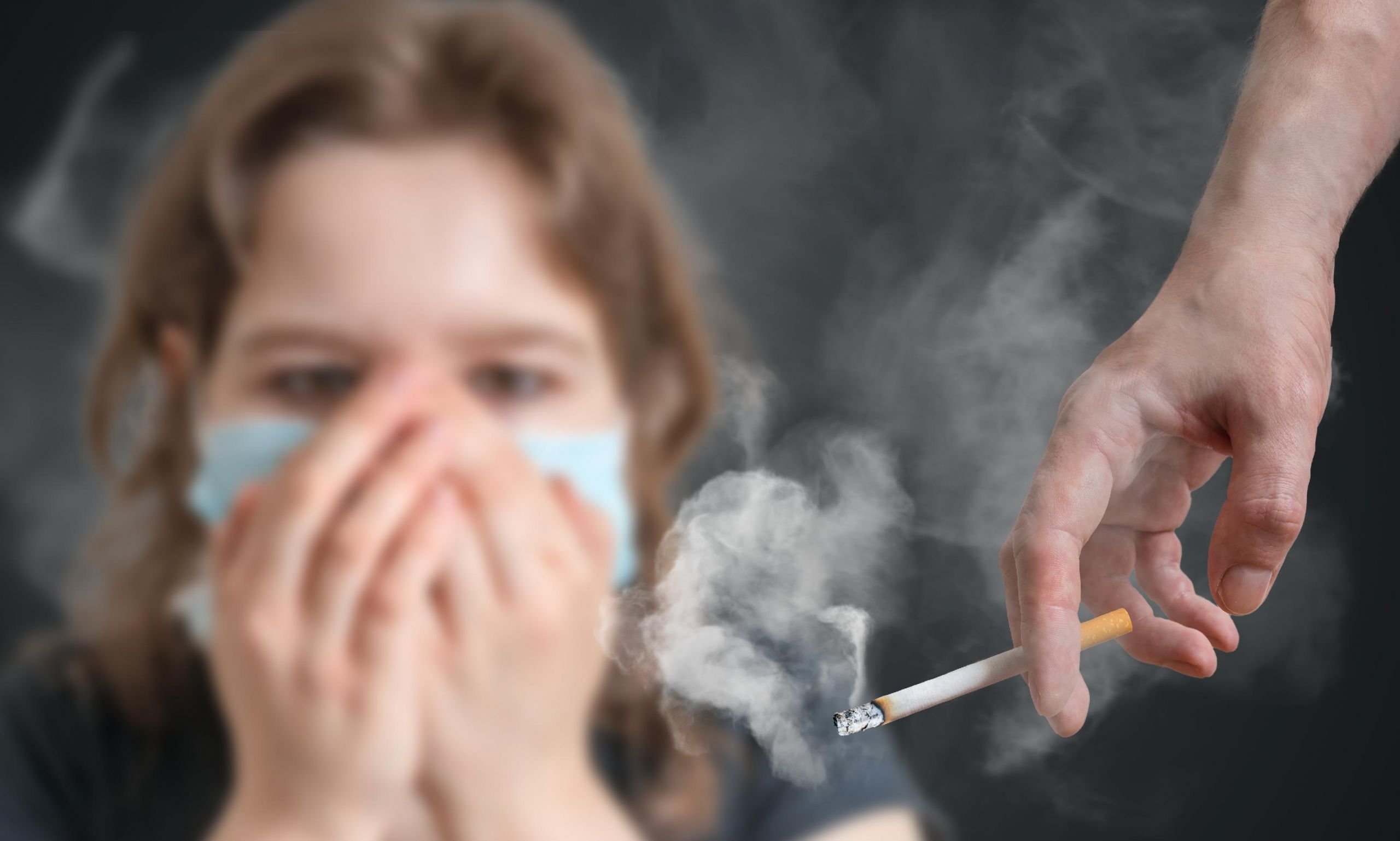TOBACCO Smoke
What is Secondhand Smoke?
Tobacco smoke contains more than 7,000 chemicals, including hundreds that are toxic and about 70 that can cause cancer. Secondhand smoke is smoke from the burning end of tobacco products, such as cigarettes, cigars, or pipes; and smoke that has been exhaled, or breathed out, by the person smoking.
Particles from secondhand tobacco smoke can settle in dust and on surfaces and remain there long after the smoke is gone. Some studies suggest the particles can last for months. When no longer in the form of airborne smoke, it is often called thirdhand smoke (THS) or residual tobacco smoke.
Secondhand smoke (SHS) has the same harmful chemicals that smokers inhale.
Do E-Cigs Emit Secondhand Smoke?
Electronic cigarettes (also called e-cigarettes, vape pens, vapes, and pod mods) are battery-powered devices designed to heat a liquid, which typically contains nicotine, into an aerosol for inhalation by a user. Following inhalation, the user exhales the aerosol.
The use of electronic cigarettes results in exposure to secondhand aerosols (rather than secondhand smoke). Secondhand aerosols contain harmful substances, including nicotine, heavy metals like lead, volatile organic compounds, and cancer-causing agents.

- at work
- at home
- in public
- in the car
There is no risk-free level of secondhand smoke exposure; even brief exposure can be harmful to health.
Is Secondhand Smoke Infiltrating Your Flat or Office?
Secondhand smoke exposure in multi-unit dwellings such as apartments and flats is unfortunately both a common problem and also dangerous for the occupants and their families . Exposure to secondhand smoke can lead to serious health problems including lung cancer, heart disease and stroke, and can make asthma worse in adults and children. It is especially dangerous for children as it can result in permanent damage to growing lungs, and cause respiratory illnesses like bronchitis and pneumonia, ear infections and sudden infant death syndrome (SIDS). Secondhand smoke can seep into multi-unit dwellings from many places, including vents and cracks in walls or floors.
How Does Secondhand Smoke Affect Non-Smokers?
Secondhand smoke is the third leading cause of preventable death in the United States, killing 53,000 nonsmokers in the U.S. each year.
If you are a non-smoker but are exposed to secondhand smoke on a regular basis, your body will still absorb nicotine and other harmful substances. Smoke contains more than 7000 chemical compounds, of which hundreds are toxic and approximately 70 are known cancer-causing agents. These dangerous substances linger in the air for approximately 4 hours before settling on to surfaces as particulates. Breathing in these chemicals and chemical laden particles for mere minutes can harm you.
Exposure time to secondhand smoke and effects:
- 5 minutes – stiffens the aorta as much as smoking a cigarette
- 20-30 minutes – can cause heart damage similar to that of habitual smokers; causes excess blood clotting, as well as increases the buildup of fat deposits in blood vessels, increasing the risk of heart attack and stroke
- 2 hours – increases the chance of irregular heartbeat (arrhythmia) and can trigger a fatal cardiac event or heart attack
The longer you are around secondhand smoke, the greater the level of harmful substances in your body. Implementing 100 percent smoke-free environments is the first step to protect yourself from the harmful effects of exposure to secondhand smoke.
Health Effects
- Ear infections
- More frequent and severe asthma attacks
- Respiratory symptoms (for example, coughing, sneezing, and shortness of breath)
- Respiratory infections (bronchitis and pneumonia)
- A greater risk for sudden infant death syndrome (SIDS)
- Heart disease
- Lung cancer
- Stroke
Detects presence of secondhand and thirdhand tobacco smoke
Low detection limit: 0.1 µg/m3
One sample covers up to 200 square metres area
Residual tobacco contamination, or “thirdhand smoke,” from cigarettes, cigars, and other tobacco products is left behind after smoking occurs and builds up on surfaces and furnishings. This residue can linger in spaces long after smoking has ceased and continue to expose people to tobacco smoke toxins. Sticky, highly toxic particulate matter, including nicotine, can cling to walls and ceilings. Gases can be absorbed into carpets, curtains , and other upholsteries, and then be reemitted (off-gassed) back into the air and recombine to form harmful compounds. Tobacco residue is noticeably present in dust throughout places where smoking has occurred.
How can you decrease Your exposure?
Enforce a 100% no smoking policy in your home and office space.
Check your lease for your apartment or rules for your flat to see if smoking is addressed or even allowed.
Talk with your neighbours about your exposure to secondhand smoke.
- If you know where the smoke is coming from and feel comfortable talking with your neighbour about it, see if an agreement can be reached about where and when they smoke. Remain calm, polite and offer solutions.
- Engage and connect with other neighbours about how secondhand smoke may be affecting them and their families and work together.
- Keep a diary noting the times and circumstances when tobacco smoke has been smelt by you and your family in your home.
Talk with your landlord/property manager about the secondhand smoke problem in your home.
Talk with your doctor if secondhand smoke is affecting your health and get a note from them that exposure to secondhand smoke is or may be contributing to your illness.
Eliminating secondhand smoke exposure is the only permanent solution
References
https://www.cancer.gov/about-cancer/causes-prevention/risk/tobacco/second-hand-smoke-fact-sheet
https://www.cdc.gov/tobacco/infographics/secondhand-smoke/index.htm#smokefree
https://www.cdc.gov/tobacco/data_statistics/fact_sheets/secondhand_smoke/general_facts/index.htm
https://www.cdc.gov/tobacco/data_statistics/fact_sheets/secondhand_smoke/health_effects/index.htm
https://my.clevelandclinic.org/health/articles/10644-secondhand-smoke-dangers
https://www.lung.org/our-initiatives/tobacco/smokefree-environments/multi-unit-housing/secondhand-smoke.html
https://no-smoke.org/secondhand-smoke-science/

